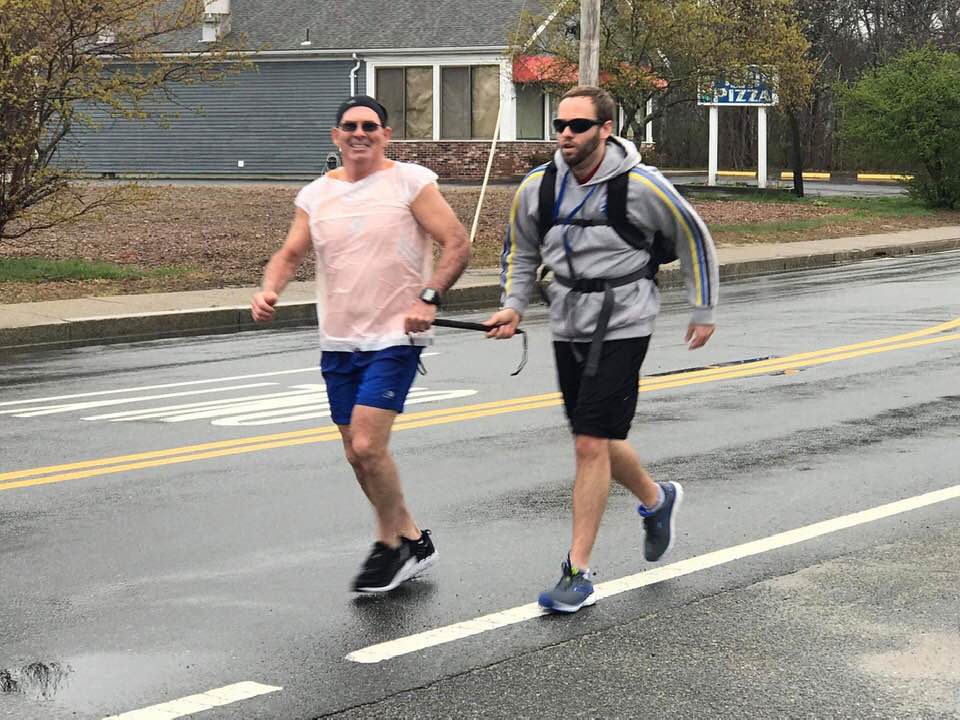My name is Brian Switzer. I am deafblind as a result of a condition called Usher Syndrome.
As a child, I attended a couple schools for the deaf before switching into a public school. I progressively went blind. I was diagnosed with sight loss at age 4, became legally blind at age 16, and now only possess some light sensitivity.
I hold a Master’s degree in Public Policy. I am a co-author on a book on living with deafblindness called, “Walk In My Shoes: An Anthology On Usher Syndrome.” And I currently work as a Program and Training Specialist at Perkins School for the Blind in the Career Launch program, which aims to get more blind and visually impaired young adults into the workforce.
But I am most well-known for being an athlete. I am known for running the Equinox Marathon – considered to be the fifth-toughest marathon in the world – through the wilderness of Alaska. I have also run the Boston and New York City marathons. I was also on the first team of all blind and visually impaired athletes to complete a Ragnar Relay Ultra. Each team member had to run 30+ miles through New Hampshire.
A New Challenge
I recently tried a new experience: training for a ruck challenge. The race that I participated in is called Ruck4HIT Cape Cod. The money supports veterans as they transition into civilian life. They provide home modifications for disabled veterans, support groups, and support animals for those who need them.
I am not a veteran, and I cannot imagine the burden that veterans carry as a result of their service. However, as someone who transitioned into blindness, I understand how difficult it can be to transition to a life with a disability. It was a very difficult experience for me, and, if I can help anyone in any way, I am happy to do so.
To start my training, I tried running with a 30-pound rucksack. Wearing the rucksack felt like a whole new experience than running without one. The first two times that I ran with it, I struggled to just lift my legs up. It was more of a march than a run.
On one of my first runs, my guide forgot to warn me that there was a curb. I barely hit the curb, but with the 30-pound rucksack, I almost toppled over. The rucksack makes you very top heavy. It is difficult to describe exactly how heavy 30 pounds is. I had several people lift up my rucksack, and they were amazed by how heavy it is.
As the training went on, my legs got stronger, and it was easier to catch myself if I started to trip.
Ready to Ruck
The race started at 12:30 a.m. on a Friday morning – and went for 38 hours straight. We finished around 2 p.m. on Saturday. We ran through two consecutive nights and I slept for about an hour in two half-hour segments.
My team ran 220+ miles through all 15 towns on Cape Cod. We started in Bourne, circled Provincetown on the tip of Cape Cod, and then returned to Mashpee. As an individual, I covered about 30 miles. Each person runs between two and four miles before handing it off to the next team member.
I had two sighted guides. The first, Michael Switzer, ran with me from the start to the halfway point. At the halfway point, they switched. I ran the rest of the way back with a guide named John Lesperance. Both guides spent almost an entire day running with me without expecting anything in return. They are both incredibly selfless individuals.
We ran together connected by a rigid tether that I crafted at home. It is a small section of an old white cane wrapped in grip tape to make it easier to hold. One day soon, I am hoping to make a better second version of the rigid tether.
Along the way, there are also three team challenges. The toughest challenge is climbing to the top of Pilgrim Monument and back down with your rucksack. Pilgrim Monument ascends 252 feet and has 116 steps. Near the top, the steps were really wet, as a result of rain. I used a combination of my guide, and my trusty white cane. The white cane gave me better information about where the step was and how high it was.
As we neared the finish line, we gathered together as a team. We met up with the motorcycle group, the Iron Order. The Iron Order led us to the finish line, revving their bikes the entire way. The team walked in two single file lines to the finish. We were greeted with loud applause. After crossing the finish, I was awarded a medal of achievement from Brigadier General Tony Schiavi for rucking while blind.
Being in a race that is typically run by strong, able-bodied people, brought a great deal of awareness to the capabilities that a lot of people who are blind possess.
When he’s not running, rucking or writing, Brian is the Program and Training Specialist for Career Launch @ Perkins. He has consulted with creators of running applications to make them more accessible, including RunKeeper and Strava. His passion for assistive technology comes from his own experience learning how to use it, and the numerous doors that learning assistive technology has opened up for him. Prior to going blind, Brian was a high school math teacher.



